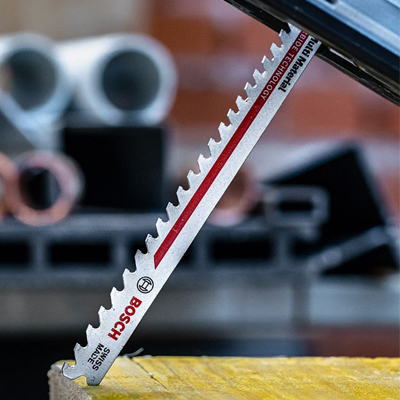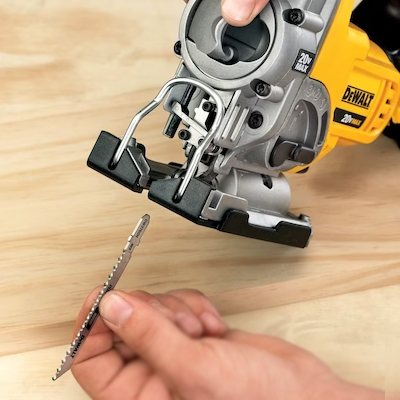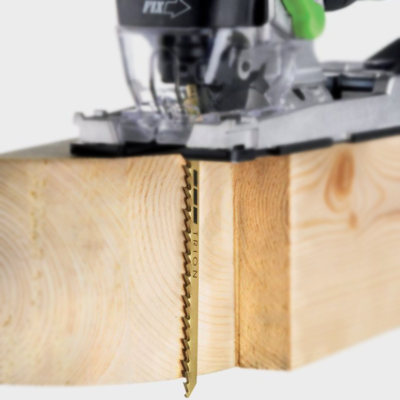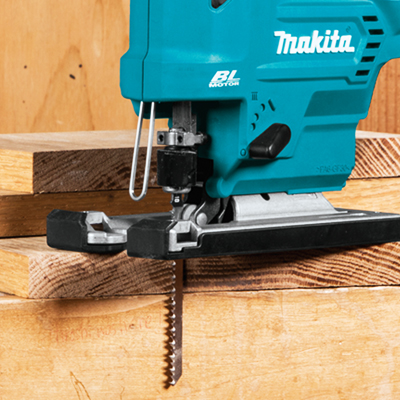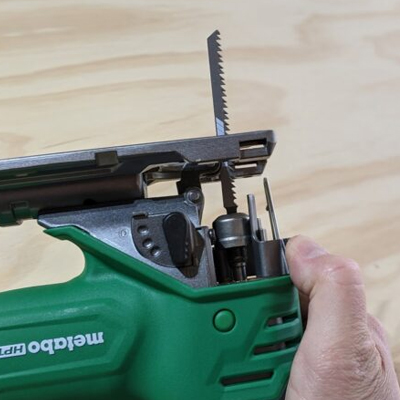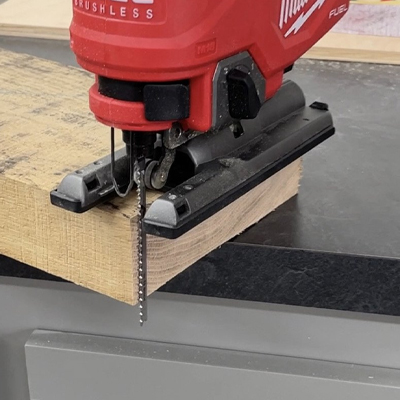Special Offer On Jigsaw Blades
Special Offer Jigsaw Blades is a versatile cutting tool designed for precision and flexibility in various woodworking, metalworking, and DIY projects. This slender, toothed blade attaches to a jigsaw, a handheld power tool known for its ability to make intricate curved cuts and straight lines effortlessly. Jigsaw blades come in an array of types, each tailored to specific materials and cutting requirements. They may feature different tooth configurations, such as T-shank or U-shank, to fit the corresponding jigsaw models. These blades typically have finely sharpened teeth arranged in a tight pattern, allowing for smooth and accurate cutting through wood, plastic, metal, or other materials. They vary in length, ranging from shorter blades for tight curves to longer ones for extended straight cuts. The choice of blade largely depends on the material thickness, desired cutting speed, and the intricacy of the design. Some blades incorporate specialized teeth designs like carbide-tipped teeth for longevity or aggressive teeth for rapid material removal. When considering the purchase of jigsaw blades, it's essential to make an informed decision to ensure that you get the right blades for your specific needs. Firstly, take into account the type of materials you'll be working with. Jigsaw blades come in various configurations, including those optimized for wood, metal, plastic, laminate, and other materials. Choosing the right blade material and tooth design is crucial to achieving clean and efficient cuts.Brands Of Jigsaw Blades
Bosch:
Bosch is a trusted name in the power tool industry, and their jigsaw blades are known for their precision and durability. This offers a wide range of jigsaw blades for cutting wood, metal, plastic, and other materials. Their blades often feature high-quality materials and advanced tooth designs for clean and efficient cuts. Bosch also provides compatibility guides to ensure users choose the right blade for their jigsaw model.DEWALT:
DEWALT is a renowned brand that produces high-performance tools and accessories. DEWALT's jigsaw blades are designed for professional use and are known for their cutting efficiency. They offer a variety of blades, including bi-metal, high carbon steel, and specialty blades for cutting different materials. DEWALT's blades are often color-coded for easy identification and selection.Makita:
Makita is a well-respected brand in the power tool industry, and their jigsaw blades are engineered for precision and longevity. It offers a range of blades designed for cutting wood, metal, plastic, and more. Their blades are known for their sharpness and accuracy, ensuring clean and smooth cuts. Makita provides a wide selection of blade profiles to suit various cutting applications.Festool:
Festool is renown for its high-quality woodworking tools and accessories. In other words, Festool jigsaw blades are designed to work seamlessly with Festool jigsaws, providing exceptional cutting performance and precision. They offer a variety of blade types, including fine-toothed blades for intricate cuts and specialty blades for different materials. Festool's blades are known for their durability and compatibility with their jigsaw systems.Milwaukee:
Milwaukee is a respect brand known for its durable and high-performance tools and accessories. This jigsaw blades is design to withstand heavy-duty use and provide precise cutting results. They offer a wide range of blades for various materials, including wood, metal, and PVC. Milwaukee's blades often feature innovative designs for improved cutting speed and longevity.Types Of Jigsaw Blades
Wood Cutting Blades:
These blades are design with fine, closely spaced teeth to deliver smooth and precise cuts in various types of wood, including softwoods and hardwoods. They are ideal for tasks like crafting intricate patterns, making curved cuts, and shaping woodwork.Metal Cutting Blades:
Metal-cutting jigsaw blades feature teeth with a different tooth pitch and shape, typically finer and more spaced out compared to wood-cutting blades. They are optimize for cutting through metals like aluminum, steel, and copper, offering clean and efficient results in metalworking projects.Plastic Cutting Blades:
These blades are specifically engineer for cutting plastic materials, including PVC, acrylic, and polycarbonate. They minimize chipping and melting while providing accurate and smooth cuts, making them suitable for projects involving plastic components.Laminate Cutting Blades:
Laminate blades are design to cut through laminate materials, such as laminate countertops or flooring. They have fine teeth and a special tooth configuration that reduces chipping and ensures precise cuts in laminates.Bi-Metal Blades:
Bi-metal blades are versatile options capable of cutting through a wide range of materials, including wood, metal, and plastic. They feature a combination of high-speed steel (HSS) teeth for durability and cobalt steel for increase heat resistance, making them long-lasting and adaptable.Tungsten Carbide-Tipped Blades:
These blades are know for their exceptional durability and longevity. After that, the tungsten carbide tips on the teeth can withstand the abrasiveness of tough materials like hardwoods, metal, and abrasive composites, making them a preferred choice for professionals.Downcut Blades:
Downcut jigsaw blades have teeth that cut in a downward motion, which is especially useful when you need to minimize splintering or chipping on the top surface of your workpiece, such as when cutting laminates or veneers.Progressive-Tooth Blades:
These blades feature teeth with varying tooth pitch along the blade's length. This design helps improve cutting efficiency by allowing for fast material removal in the initial part of the cut and smoother finishing towards the end, making them suitable for versatile cutting tasks.Reverse-Tooth Blades:
These blades have teeth pointing upward at the blade's front end and downward at the rear end. Similarly, this design helps reduce splintering on the top surface of the material being cut. Making them an excellent choice for clean cuts in laminates, veneers, and delicate woods.Features:
- Tooth Configuration: Jigsaw blades come in different tooth configurations, including T-shank and U-shank. T-shank blades are more common and offer quick and tool-free blade changes, while U-shank blades require a tool to change but may fit older jigsaw models.
- Material Compatibility: Jigsaw blades are design for specific materials like wood, metal, plastic, or laminate. Some blades are versatile and can handle multiple materials.
- Tooth Design: Blades can have different tooth designs, such as fine teeth for smooth cuts or aggressive teeth for fast material removal. Tungsten carbide-tipped teeth provide exceptional durability.
- Length: Blade length varies to accommodate different cutting needs, from short blades for intricate curves to longer blades for straight cuts.
- Specialty Blades: Some blades are specialize for unique applications, such as scroll-cutting blades, flush-cutting blades, and carbide-grit blades for specific materials.
Benefits:
- Versatility: Jigsaw blades can cut various materials, making them suitable for a wide range of projects, including woodworking, metalworking, and DIY tasks.
- Precision: Jigsaws equipped with the right blade allow for intricate and curved cuts, making them ideal for creating detailed designs and custom shapes.
- Efficiency: These blades can cut quickly and efficiently, helping you complete tasks faster and with less effort.
- Ease of Use: Many jigsaw blades feature tool-free installation, simplifying the process of changing blades and reducing downtime.
- Reduced Material Waste: The fine teeth and reciprocatory motion of jigsaw blades minimize splintering and chipping. After that, it leads to cleaner and more precise cuts, which reduces material waste.
Safety Considerations:
- Eye Protection: Always wear safety glasses or goggles when using a jigsaw to protect your eyes from debris and splinters.
- Ear Protection: Jigsaws can be noisy, so wearing ear protection is essential to prevent hearing damage.
- Grip and Control: Maintain a firm grip on the jigsaw, keeping both hands on the tool, and ensure you have full control over the workpiece.
- Workpiece Stability: Secure your workpiece to a stable surface or use clamps to prevent it from moving while cutting.
- Blade Selection: Choose the appropriate blade for the material and task to ensure safe and effective cutting.
- Follow Manufacturer's Instructions: Read and follow the manufacturer's safety guidelines and instructions for your specific jigsaw model.
- Turn off Power: Always disconnect the power source before changing blades or making any adjustments to the tool.
- Keep Hands Clear: Keep your hands and body clear of the cutting area and the path of the blade to prevent accidental contact.

